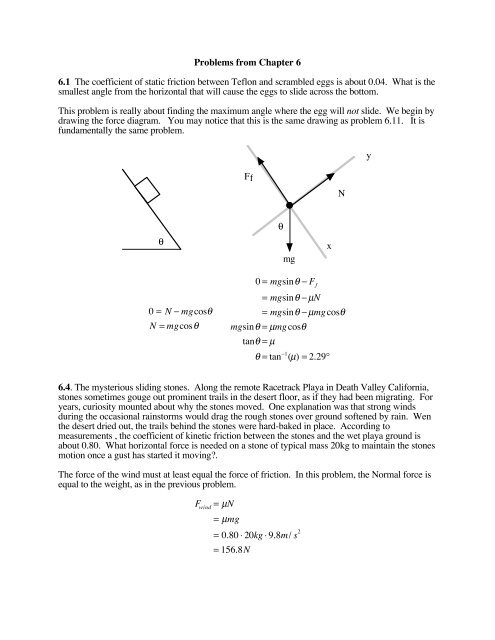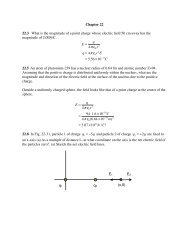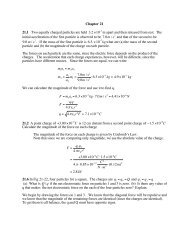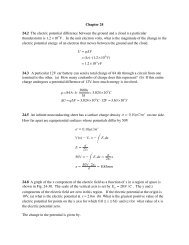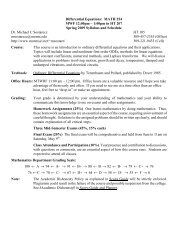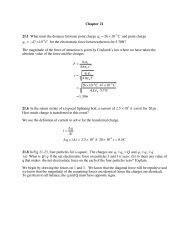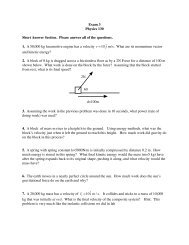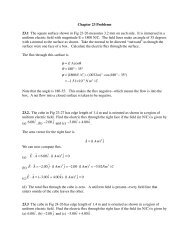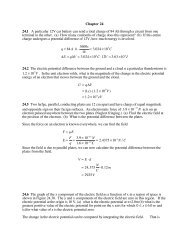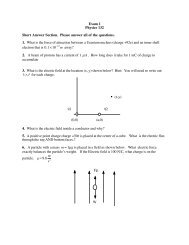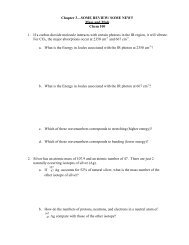Problems from Chapter 6 6.1 The coefficient of static friction between ...
Problems from Chapter 6 6.1 The coefficient of static friction between ...
Problems from Chapter 6 6.1 The coefficient of static friction between ...
You also want an ePaper? Increase the reach of your titles
YUMPU automatically turns print PDFs into web optimized ePapers that Google loves.
<strong>Problems</strong> <strong>from</strong> <strong>Chapter</strong> 6<br />
<strong>6.1</strong> <strong>The</strong> <strong>coefficient</strong> <strong>of</strong> <strong>static</strong> <strong>friction</strong> <strong>between</strong> Teflon and scrambled eggs is about 0.04. What is the<br />
smallest angle <strong>from</strong> the horizontal that will cause the eggs to slide across the bottom.<br />
This problem is really about finding the maximum angle where the egg will not slide. We begin by<br />
drawing the force diagram. You may notice that this is the same drawing as problem <strong>6.1</strong>1. It is<br />
fundamentally the same problem.<br />
Ff<br />
N<br />
y<br />
θ<br />
θ<br />
mg<br />
x<br />
0 = N − mgcosθ<br />
N = mgcosθ<br />
0 = mgsinθ − F f<br />
= mgsinθ − µN<br />
= mgsinθ − µmgcosθ<br />
mgsinθ = µmgcosθ<br />
tanθ = µ<br />
θ = tan −1 (µ) = 2.29°<br />
6.4. <strong>The</strong> mysterious sliding stones. Along the remote Racetrack Playa in Death Valley California,<br />
stones sometimes gouge out prominent trails in the desert floor, as if they had been migrating. For<br />
years, curiosity mounted about why the stones moved. One explanation was that strong winds<br />
during the occasional rainstorms would drag the rough stones over ground s<strong>of</strong>tened by rain. Wen<br />
the desert dried out, the trails behind the stones were hard-baked in place. According to<br />
measurements , the <strong>coefficient</strong> <strong>of</strong> kinetic <strong>friction</strong> <strong>between</strong> the stones and the wet playa ground is<br />
about 0.80. What horizontal force is needed on a stone <strong>of</strong> typical mass 20kg to maintain the stones<br />
motion once a gust has started it moving?.<br />
<strong>The</strong> force <strong>of</strong> the wind must at least equal the force <strong>of</strong> <strong>friction</strong>. In this problem, the Normal force is<br />
equal to the weight, as in the previous problem.<br />
F wind<br />
= µN<br />
= µmg<br />
= 0.80 ⋅ 20kg ⋅ 9.8m/ s 2<br />
= 156.8N
6.20 A loaded penguin sled weight 80N rests on a plane inclined at 20 degrees to the horizontal.<br />
Between the sled and the plane, the <strong>coefficient</strong> <strong>of</strong> <strong>static</strong> <strong>friction</strong> is 0.25, and the <strong>coefficient</strong> <strong>of</strong> kinetic<br />
<strong>friction</strong> is 0.15. (a) What is the minimum magnitude <strong>of</strong> the force F, parallel to the plane, that will<br />
prevent the sled <strong>from</strong> slipping down the plane. (b) What is the minimum magnitude F that will start<br />
the sled moving up the plane? (c) What value F is required to move the sled with constant velocity<br />
up the incline.<br />
a) We begin by drawing the forces. Since the motion would be downward if F is too small, we<br />
draw Friction as pointing UP the incline for part a.<br />
y<br />
N<br />
Ff<br />
F<br />
N<br />
Ff<br />
x<br />
F<br />
W=mg<br />
W=mg<br />
We now write the forces in component form. Since the sled is not to move, the net force will be<br />
zero.<br />
y − direction<br />
0 = N − mgcosθ<br />
N = mgcosθ<br />
x − direction<br />
0 = F + F f<br />
− mgsinθ<br />
F = mgsinθ − F f<br />
= mgsinθ − µN<br />
= mgsinθ − µ s<br />
mgcosθ<br />
= 80N sin20 −0.25 ⋅ 80N ⋅ cos20<br />
= 8.57N<br />
b) In this section, we wish to get the block moving. <strong>The</strong> drawing will change, because the<br />
<strong>friction</strong>al force acts downward as it opposes the upward motion
N<br />
y<br />
F<br />
N<br />
x<br />
F<br />
Ff<br />
Ff<br />
W=mg<br />
y − direction<br />
0 = N − mgcosθ<br />
N = mgcosθ<br />
W=mg<br />
x − direction<br />
0 = F − F f<br />
− mgsinθ<br />
F = mgsinθ + F f<br />
= mgsinθ + µ N<br />
= mgsinθ + µ s<br />
mgcosθ<br />
= 80N sin20 + 0.25⋅ 80N ⋅ cos20<br />
= 46.2N<br />
c) <strong>The</strong> drawing for c is the same as for b), but since the sled is now moving with constant speed<br />
(not just starting) we need use the kinetic <strong>coefficient</strong> <strong>of</strong> <strong>friction</strong>.<br />
y − direction<br />
0 = N − mgcosθ<br />
N = mgcosθ<br />
x − direction<br />
0 = F − F f<br />
− mgsinθ<br />
F = mgsinθ + F f<br />
= mgsinθ + µ N<br />
= mgsinθ + µ k<br />
mgcosθ<br />
= 80N sin20 + 0.15⋅ 80N ⋅ cos20<br />
= 38.6N<br />
6.21. Block B in Fig. 6-30 weights 711N. <strong>The</strong> <strong>coefficient</strong> <strong>of</strong> <strong>static</strong> <strong>friction</strong> <strong>between</strong> block and<br />
horizontal surface is 0.25. Find the maximum weight block A for which the system will be<br />
stationary.<br />
This problem is a classic “<strong>static</strong>s” problem where the net force on the two blocks and the knot.<br />
We begin by drawing the forces on the two blocks and on the knot.
TW<br />
TW<br />
TB<br />
B<br />
TB<br />
TA<br />
30˚<br />
TA<br />
TA<br />
A<br />
WA<br />
N<br />
Ff<br />
TB<br />
<strong>The</strong> forces on A allow us to find the tension TA.<br />
WB<br />
0 = T A<br />
− W A<br />
T A<br />
= W A<br />
Now we write forces on the knot<br />
0 = T W<br />
sin30 − T A<br />
T W<br />
=<br />
T A<br />
sin 30 = W A<br />
sin 30<br />
0 = T W<br />
cos30 − T B<br />
T B<br />
= T W<br />
cos30<br />
= W A<br />
sin 30 ⋅cos30<br />
T B<br />
= W A<br />
cot 30<br />
and on B. We then substitute and solve for the weight <strong>of</strong> A.
0 = N −W B<br />
N = W B<br />
0 = T B<br />
− F f<br />
T B<br />
= F f<br />
W A<br />
cot 30 = µ N<br />
W A<br />
= µN<br />
cot 30<br />
= µ W B<br />
tan30<br />
= 0.25 ⋅ 711N ⋅ tan30<br />
=102.6N<br />
6.27 Body A in Fig 6-34 weights 102 N and body B weights 32N. <strong>The</strong> <strong>coefficient</strong>s <strong>of</strong> <strong>friction</strong><br />
<strong>between</strong> A and the include are µ s<br />
= 0.56 and µ k<br />
= 0.25. <strong>The</strong> angle is 40 degrees. Find the<br />
acceleration <strong>of</strong> A if (a) A is initially at rest, (b) A is initially moving up the incline, and (b) A is<br />
initially moving down the incline.<br />
We begin, as always by drawing the forces. Lets assume that the <strong>static</strong> <strong>friction</strong> is keeping A <strong>from</strong><br />
sliding down.<br />
a) If A is initially at rest, it has no acceleration.<br />
A<br />
N<br />
Ff<br />
y<br />
F<br />
f<br />
T<br />
x<br />
T<br />
θ<br />
b) For a mass sliding upward.<br />
B<br />
mAg<br />
θ<br />
Mass A<br />
0 = N − m A<br />
g cosθ<br />
N = m A<br />
g cosθ<br />
m A<br />
a = T − F f<br />
− m A<br />
gsinθ<br />
= T − µN − m A<br />
gsinθ<br />
= T − µ m A<br />
gcosθ − m A<br />
gsinθ<br />
Mass B<br />
m B<br />
a = m B<br />
g − T<br />
We now solve for T and plug in to find a.
T = m B<br />
g − m B<br />
a<br />
m A<br />
a = T − µ m A<br />
gcosθ − m A<br />
gsinθ<br />
m A<br />
a = m B<br />
g − m B<br />
a − µ m A<br />
gcosθ − m A<br />
gsinθ<br />
a = m B g − µ m A gcosθ − m A gsinθ<br />
m A<br />
+ m B<br />
If the mass is sliding up initially, we find a using the <strong>coefficient</strong> <strong>of</strong> kinetic <strong>friction</strong><br />
a =<br />
m g − µ m gcosθ − m gsinθ<br />
B A A<br />
m A<br />
+ m B<br />
32N −0.25 ⋅102N ⋅ cos40 −102N sin 40<br />
=<br />
(32N +102N) / 9.8m / s 2<br />
= −3.89m / s 2<br />
If the mass is sliding downward, we simply reverse the <strong>friction</strong>al piece <strong>of</strong> the expression.<br />
A<br />
N<br />
Ff<br />
y<br />
Ff<br />
θ<br />
T<br />
x<br />
T<br />
θ<br />
that is sliding downward<br />
B<br />
mAg<br />
mBg<br />
For a mass<br />
a =<br />
m g + µ m gcosθ − m gsinθ<br />
B A A<br />
m A<br />
+ m B<br />
32N + 0.25⋅102N ⋅ cos 40 −102N sin40<br />
=<br />
(32N +102N) / 9.8m / s 2<br />
= −1.03m / s 2<br />
6.36 Suppose the <strong>coefficient</strong> <strong>of</strong> <strong>static</strong> <strong>friction</strong> <strong>between</strong> the road and the tires on a car is 0.6 and the
care has no negative lift. What speed will put the care on the verge <strong>of</strong> sliding as it rounds a level<br />
curve <strong>of</strong> 30.5 m radius.<br />
mv 2<br />
= µ N<br />
r<br />
N = mg<br />
mv 2<br />
= µ mg<br />
r<br />
v 2 = rg<br />
v = rg = 30.5 ⋅ 9.8<br />
=17.28m / s<br />
6.45. An airplane is flying in a horizontal circle at a speed <strong>of</strong> 480 km/h. If the wings <strong>of</strong> the plane<br />
are tilted 40˚ to the horizontal, what is the radius <strong>of</strong> the circle in which the plane is flying. Assume<br />
that the required force is provided entirely by an aerodynamic lift that is perpendicular to the wing<br />
surface.<br />
y<br />
40˚<br />
FL<br />
x<br />
40˚<br />
mg<br />
We write the forces and set the net inward force equal to the centripetal force. 480 km/h=133.3m/s.
0 = F L<br />
cos40 − mg<br />
F L<br />
cos40 = mg<br />
F L<br />
=<br />
mg<br />
cos 40<br />
F net−in<br />
= ma = m v2<br />
r = F L<br />
sin 40<br />
m v2<br />
r = ( mg<br />
) ⋅sin 40<br />
cos40<br />
v 2<br />
r<br />
r =<br />
= gtan 40<br />
v 2 (133.3m / s)2<br />
=<br />
gtan 40 9.8m / s 2 ⋅ tan 40<br />
= 2160.8m


